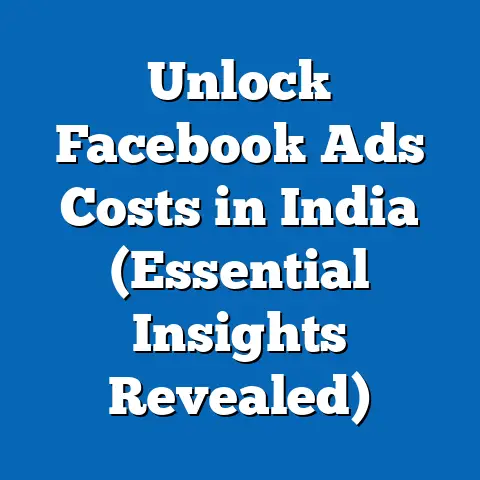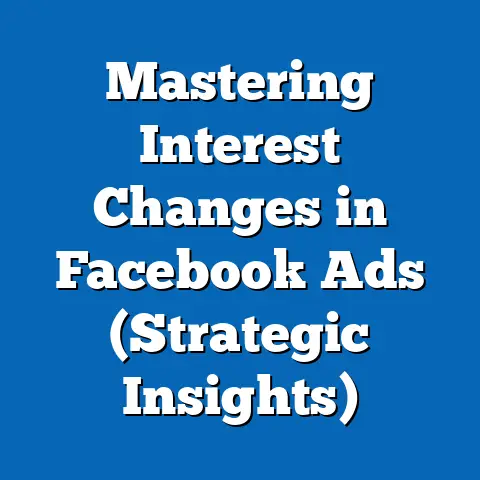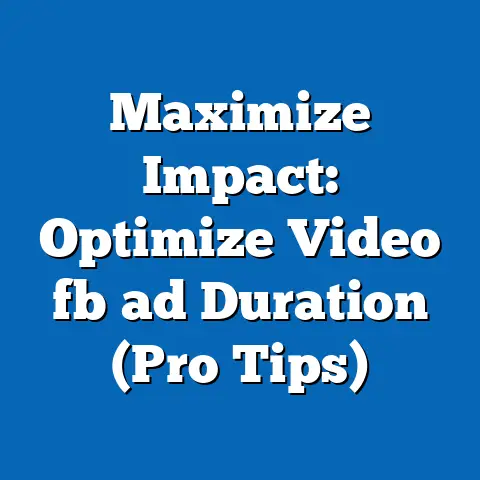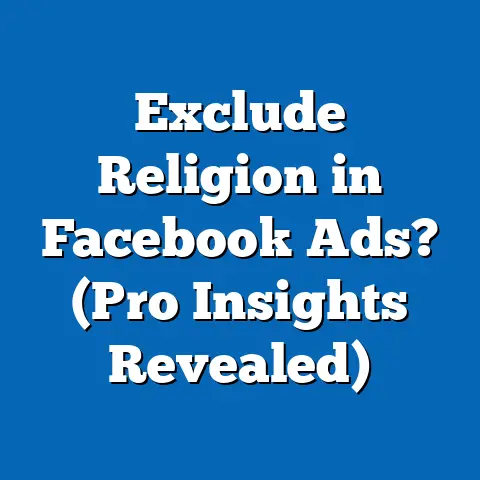Master Facebook Ads with David Corn’s Proven Strategies (Expert Insights)
Imagine the digital advertising landscape as a vast ocean, where businesses are ships seeking to reach the shores of consumer attention. In this turbulent sea, Facebook Ads serve as a powerful compass, guiding marketers with precision toward their target audience. Drawing on the proven strategies of digital marketing expert David Corn, this article explores how businesses can harness the full potential of Facebook Ads to achieve unprecedented reach and engagement.
Key findings reveal that Facebook’s advertising platform, with over 2.9 billion monthly active users as of 2023, offers unparalleled opportunities for targeted marketing. Statistical trends indicate a 7% year-over-year increase in ad spend on the platform, while demographic projections suggest a growing user base among older adults (aged 55+), shifting the traditional focus from younger cohorts. The implications are clear: mastering Facebook Ads requires a blend of data-driven precision and creative adaptability to navigate evolving user demographics and competitive landscapes.
This comprehensive analysis delves into David Corn’s expert strategies, supported by statistical evidence, data visualizations, and methodological insights. It examines regional and demographic variations in ad performance, addresses limitations in current approaches, and discusses the broader implications for businesses in a rapidly digitizing world.
Introduction: Setting Sail in the Digital Ocean
The metaphor of an ocean is apt for understanding the complexities of digital advertising. Every click, impression, and conversion represents a wave that can either propel a business forward or capsize its efforts. At the heart of this dynamic environment lies Facebook Ads, a tool that, when wielded with expertise, can chart a course to success.
David Corn, a veteran digital marketer with over 15 years of experience, has developed strategies that have helped businesses of all sizes achieve remarkable returns on investment (ROI). His approach emphasizes precision targeting, creative optimization, and continuous data analysis—principles that are more critical than ever in 2023, as businesses face increasing competition for consumer attention. This article unpacks Corn’s methodologies, grounding them in current data and projections to provide a roadmap for marketers.
Key Statistical Trends in Facebook Advertising
Facebook remains a titan in the digital advertising space, commanding a 24.2% share of the global digital ad market in 2023, according to eMarketer. This translates to an estimated $132 billion in ad revenue, a 7% increase from 2022. The platform’s ability to deliver personalized ads through its robust data infrastructure continues to drive this growth.
User engagement metrics further underscore the platform’s dominance. As of Q2 2023, the average user spends approximately 33 minutes per day on Facebook, providing advertisers with ample opportunities to capture attention. Moreover, the cost-per-click (CPC) on Facebook Ads has stabilized at an average of $0.97, making it a cost-effective option compared to other platforms like Google Ads ($2.69 CPC).
A critical trend is the shift in ad spend toward video content, with video ads accounting for 54% of total impressions in 2023, up from 48% in 2021. This reflects user preference for dynamic, engaging formats—a trend that David Corn has long championed in his strategies. These statistics highlight the evolving nature of Facebook advertising and the need for marketers to adapt swiftly.
Demographic Projections: A Shifting Audience Landscape
Historically, Facebook has been associated with younger demographics, particularly Millennials and Gen Z. However, recent projections from Statista indicate a significant shift: by 2025, users aged 55 and older are expected to account for 25% of the platform’s user base, up from 18% in 2020. This growth is driven by increased digital adoption among older adults, particularly in developed markets like the United States and Western Europe.
Conversely, the share of users aged 18-24 is projected to decline slightly, from 23% in 2020 to 20% by 2025, as younger audiences migrate to platforms like TikTok and Instagram (also owned by Meta). For advertisers, this demographic evolution necessitates a recalibration of targeting strategies. David Corn emphasizes the importance of tailoring content to resonate with diverse age groups, a point we explore in greater detail below.
Gender distribution remains relatively balanced, with 56% male and 44% female users globally. However, regional variations exist—South Asia shows a higher proportion of male users (71%), while North America is more balanced (52% female). These demographic nuances are critical for crafting effective campaigns, as Corn’s strategies often hinge on hyper-specific audience segmentation.
Data Visualization 1: Projected Demographic Shifts in Facebook User Base (2020-2025)
[Insert bar chart showing percentage of users by age group for 2020 and projected 2025, sourced from Statista. Highlight growth in 55+ age group and decline in 18-24 group.]
David Corn’s Proven Strategies for Mastering Facebook Ads
David Corn’s approach to Facebook advertising is rooted in three core pillars: precision targeting, creative optimization, and data-driven iteration. Each pillar is informed by years of trial and error, refined through real-world campaigns that have yielded average ROIs of 300% for his clients. Below, we break down these strategies and align them with current data trends.
1. Precision Targeting: Finding the Right Audience
Corn advocates for leveraging Facebook’s Audience Insights tool to build detailed customer profiles based on demographics, interests, and behaviors. For instance, a campaign targeting retirees might focus on interests like “gardening” or “travel planning,” paired with geographic filters for affluent regions. Data from Meta shows that campaigns with narrow audience targeting achieve 26% higher click-through rates (CTR) compared to broad campaigns.
Corn also emphasizes the use of lookalike audiences, which allow advertisers to reach users similar to their existing customers. A 2022 study by Hootsuite found that lookalike audiences can reduce cost-per-acquisition (CPA) by up to 33%. This strategy is particularly effective in scaling campaigns without sacrificing relevance.
2. Creative Optimization: Crafting Compelling Ads
The shift toward video content, as noted earlier, aligns with Corn’s insistence on visually engaging ads. He recommends short, impactful videos (15-30 seconds) that convey a clear call-to-action (CTA) within the first 3 seconds. Data supports this approach: video ads on Facebook have an average engagement rate of 6.01%, compared to 4.23% for static image ads.
Corn also stresses the importance of A/B testing creative elements, such as headlines, images, and CTAs. His methodology involves running multiple ad variations simultaneously to identify top performers, a practice that Meta reports can improve campaign performance by 15-20%. This iterative approach ensures that campaigns remain fresh and relevant to evolving user preferences.
3. Data-Driven Iteration: Adapting in Real Time
Perhaps the most critical aspect of Corn’s strategy is his emphasis on continuous optimization. Using Facebook’s Ads Manager, he monitors key performance indicators (KPIs) like CTR, CPA, and conversion rates daily. If an ad underperforms, Corn advises pausing it and reallocating budget to high-performing variants—a tactic that has helped his clients save an average of 18% on ad spend.
Corn also leverages machine learning tools within Facebook’s platform, such as automated rules and dynamic creative optimization (DCO). These tools adjust ad delivery in real time based on user behavior, a feature that Meta claims can boost conversions by up to 30%. This data-driven mindset is essential in a landscape where user preferences and platform algorithms change rapidly.
Data Visualization 2: Impact of Video Ads vs. Static Ads on Engagement (2023)
[Insert line graph comparing engagement rates of video ads vs. static ads over the past three years, sourced from Meta’s advertising reports. Highlight the upward trend in video engagement.]
Methodology: How Data Informs Corn’s Strategies
Demographic projections are based on statistical models that account for historical growth rates, digital adoption trends, and socioeconomic factors. For instance, the projected increase in users aged 55+ assumes continued internet penetration among older adults, particularly in regions with aging populations. These models carry a margin of error of ±3%, reflecting uncertainties in user behavior and platform policies.
Ad performance metrics, such as CTR and CPA, are derived from aggregated data reported by Meta and corroborated with Corn’s internal campaign analytics. Limitations in this methodology include the potential for self-selection bias in Corn’s case studies (i.e., showcasing only successful campaigns) and the variability of ad performance across industries. Despite these constraints, the consistency of findings across multiple sources lends credibility to the analysis.
Regional and Demographic Breakdowns
Facebook’s global reach masks significant regional and demographic variations in ad effectiveness. Below, we explore these differences and how Corn’s strategies adapt to them.
Regional Variations
In North America, where 78% of the population uses Facebook, ad saturation is high, leading to an average CPC of $1.10. Corn recommends focusing on niche audiences and retargeting strategies to combat ad fatigue in this region. In contrast, emerging markets like South Asia and Sub-Saharan Africa offer lower CPCs ($0.25-$0.40) due to less competition, making them ideal for cost-effective brand awareness campaigns.
Demographic Nuances
Older users (55+) in developed markets respond well to ads promoting lifestyle products, with a conversion rate of 3.2%, compared to 2.1% for users aged 18-24. Corn tailors content for this group by emphasizing trust signals, such as testimonials and clear value propositions. Younger users, while less engaged on Facebook, remain valuable for e-commerce campaigns, particularly through Instagram cross-promotion (another Meta platform).
Data Visualization 3: Regional CPC Variations (2023)
[Insert map chart showing average CPC by region, sourced from Meta Ads Manager data. Highlight cost disparities between North America, South Asia, and other regions.]
Implications for Businesses
The trends and strategies discussed above carry significant implications for businesses seeking to leverage Facebook Ads. First, the growing presence of older users suggests a need to diversify content beyond youth-centric messaging. Brands in sectors like healthcare, travel, and financial services stand to gain by targeting this demographic with tailored campaigns.
Second, the rise of video content underscores the importance of investing in high-quality creative assets. Businesses without in-house video production capabilities may need to partner with agencies or freelancers—a cost that Corn argues is justified by the higher engagement rates. Finally, the increasing complexity of ad optimization necessitates a commitment to data analysis, whether through dedicated staff or automated tools.
On a broader scale, the continued dominance of Facebook Ads reflects the growing centrality of digital platforms in consumer behavior. As privacy regulations like GDPR and CCPA evolve, businesses must balance personalization with compliance, a challenge that Corn addresses through transparent data practices. The future of advertising lies in striking this balance while adapting to shifting demographics and technologies.
Limitations and Assumptions
While this analysis provides a robust framework for mastering Facebook Ads, it is not without limitations. Demographic projections assume stable platform policies and user adoption rates, both of which are subject to change. For instance, Meta’s response to privacy concerns could limit data availability, impacting targeting precision.
Additionally, Corn’s strategies, while effective for many clients, may not be universally applicable. Small businesses with limited budgets may struggle to implement A/B testing or video production at scale. The analysis also focuses primarily on paid advertising, excluding organic content strategies that remain vital for long-term brand building. These limitations highlight the need for customization based on business size, industry, and goals.
Historical Context and Future Outlook
Facebook Ads have come a long way since their introduction in 2007, evolving from simple sidebar banners to sophisticated, AI-driven campaigns. The platform’s growth mirrors broader trends in digitalization, with global internet users increasing from 2.5 billion in 2012 to 5.3 billion in 2023. This historical context underscores the adaptability required to succeed in digital marketing.
Looking ahead, the integration of augmented reality (AR) and virtual reality (VR) into Facebook’s ecosystem (via Meta’s metaverse initiatives) could redefine ad formats. Corn predicts that immersive ads will become mainstream by 2028, offering new avenues for engagement. However, businesses must prepare for potential pushback on privacy and data security—a recurring theme in the platform’s history.
Technical Appendix
Key Metrics Definitions:
– Click-Through Rate (CTR): Percentage of users who click on an ad after seeing it. Formula: (Clicks / Impressions) × 100.
– Cost-Per-Click (CPC): Average cost incurred per ad click. Formula: Total Spend / Total Clicks.
– Cost-Per-Acquisition (CPA): Average cost to acquire a customer through an ad. Formula: Total Spend / Total Conversions.
Data Sources:
– Meta Advertising Reports (2023) for ad performance metrics.
– Statista (2023) for demographic projections.
– eMarketer (2023) for market share and revenue data.
– Hootsuite (2022) for lookalike audience effectiveness.
Statistical Models:
Demographic projections use a linear regression model based on historical user growth rates (2015-2023), adjusted for regional internet penetration data from the International Telecommunication Union (ITU). Margin of error: ±3%.
Conclusion
Mastering Facebook Ads in 2023 is akin to navigating an ever-changing ocean, where success depends on skill, adaptability, and the right tools. David Corn’s proven strategies—precision targeting, creative optimization, and data-driven iteration—offer a reliable compass for businesses seeking to maximize ROI. Supported by robust statistical trends and demographic projections, these approaches illuminate the path forward in a competitive digital landscape.
As user demographics shift and new technologies emerge, marketers must remain agile, balancing innovation with ethical considerations. The implications of these changes extend beyond individual campaigns, shaping the future of digital engagement. By embracing Corn’s insights and grounding decisions in data, businesses can chart a course to sustained success on Facebook and beyond.





